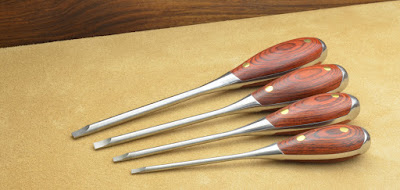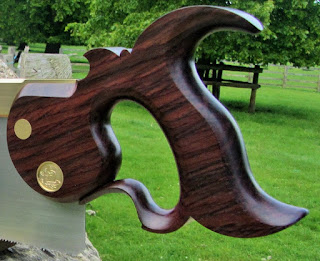Every once in a while life throws up a wonderful opportunity that's just too good to miss. So when Quangsheng told me they had one available development slot left for 2014/15 and invited me to design a product to fill it, I absolutely leapt at the chance.
I chose as my starting point, the humble but much loved Record 043 plough plane (US = plow plane), a British designed tool introduced in 1934 and last made in 1978. During that time it sold in vast numbers and was copied by several other manufacturers in England and even as far away as Russia, but not as yet by anyone who sought to improve upon it.
The 43 has one very useful role that most woodworkers discover a need for when they start making drawers, picture frames, windowsills or simple boxes with sliding lids. It cuts grooves, the narrow housings that accept a panel, like a drawer bottom, or a box lid, or the slot for the glass in a picture frame. Thanks to the relieved fence it can also cut rebates on the edge of a board for carcasses and bookcases. The depth is governed by a depth stop (often missing on secondhand examples) and the distance from the edge is set by adjusting the fence.
To knack to cutting a good groove is to start with a short cut at the end of the board and go a little further back with each pass. The plane takes a fairly heavy shaving so you reach depth quickly, quietly and without the clouds of fine dust that you get with a router.
Despite the massive numbers of these tools that were produced and sold, good quality complete examples are getting thin on the ground. Buying two or three and then cannibalising them for parts is all well and good, but as secondhand prices and postage costs rise that too becomes an expensive game. So the question now was, if we are going to produce a new one, how can we make this wonderful tool even better?
The first thing to go was the uncomfortable stippled casting web at the back, the 'knuckle grater'. In the iron casting it is there for strength, but by using stainless steel instead, we could give the new 43 a larger open loop handle that is both stronger and more comfortable to hold. The design engineer at QS came up with the wonderfully neat solution of using the rear fence rod hole to brace the corner whilst also rotating the clamping screw out of the way.
The original plane came with three imperial blades as standard with additional sizes and metric blades available separately. Since metric is now the order of the day for sheet goods (even in America - shhh don't tell em!) the new version has eight blades, four metric and four imperial. In practical terms that gives you four options for a tight fit and four options for a sliding fit to allow for movement. If you need the occasional wider housing or rebate, you can always reset the fence and make a second series of passes. The cutters are all precision ground from 3mm thick T10 carbon steel with relieved sides to eliminate binding. They are hardened to RC63.
Rather than expecting the user to make their own fence, we decided it would be better to include a factory made rosewood one and give the user the option to take it off if they want to. The original 043 had screw holes for attaching a wooden fence and for those that ever got around to making one, this addition improved the stability of the tool no end.
The last alteration was to extend the usefulness of the tool by adding a clamp to the skate that can be used to attach a saw blade. This extends the usefulness of the tool by enabling it to cut very narrow grooves, create a guide kerf for resawing boards to width, or accurately cut stringing from the corner of a planed blank with a minimum of waste.
Much of the inspiration for this feature came from Tom Fidgen of The Unplugged Woodshop. Tom is a great advocate of kerfing planes and his design for a shopmade kerfing plane is one of the most popular plans in his first book. Here's a short video of Tom trying out the prototype Quangsheng 043 with the saw attachment. He had just about bottomed out the cut by the time I got my phone fired up, but you get the idea.
Since then we have made some further refinements to the design of the sawplate and are now having the saws manufactured in the UK, they will be available shortly as an optional extra.
Needless to say, I am absolutely delighted with the result. The lightness and compact, manageable feel of the original is retained, but with greater comfort, better materials and lashings of extra versatility. Groovy!
If you're in North America you will need to pester your local Woodcraft to stock them. For the rest of the world the Quangsheng Luban No.043 is available here:














































